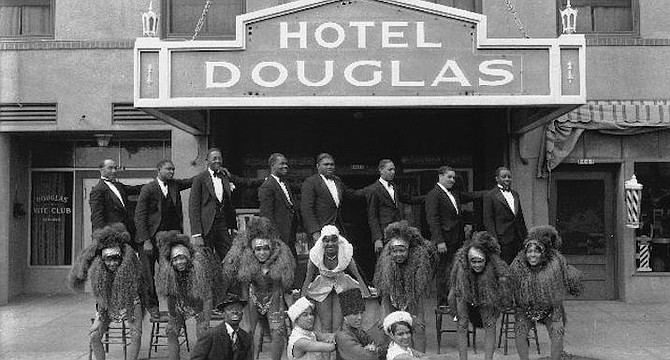 Facebook
Facebook
 X
X
 Instagram
Instagram
 TikTok
TikTok
 Youtube
Youtube

“HARLEM OF THE WEST: THE DOUGLAS HOTEL & CREOLE PALACE NITE CLUB”
MICHAEL AUSTIN, MASTER’S THESIS
During the 1930s and ’40s, the famous “Chittlin Circuit” always stopped in San Diego. The country’s top African-American entertainers — Bessie Smith, Billie Holiday, the Mills Brothers, the Inkspots, Duke Ellington, Lionel Hampton, Count Basie — performed at the Creole Palace and stayed at the Douglas Hotel. Patrons danced the Lindy Hop, the Black Bottom, the Shimmy, and the Susie Q, and the Palace came to be known, in the minds of many, as “Cotton Club West.”
The Douglas Hotel was the only “place of quality lodging and entertainment for black visitors to San Diego during a period of intense segregation in the United States.” Plus, “while black people were not allowed to enter other San Diego businesses, the Douglas served everyone” and had a color-blind hiring policy.
In 1924, William McClosky built the hotel on the corner of Second and Market Street — block H-90, lots E, F, and G. The building included a restaurant, card room, billiard room, and a “nite club." Later called the Creole Palace, the club had a capacity of 200 people.
McClosky built the hotel for Robert Rowe and George Ramsey. Rowe died shortly after the hotel opened. His wife, Mabel, co-managed the Douglas with Ramsey. Employees called her “Miss Mabel.” She lived in a suite at the hotel with her poodle. “A loud-talking woman,” Miss Mabel “draped herself in jewelry.”
She was also a well-known madam who ran Leroy’s Room, a bordello at Fourth and G in the Gaslamp. “It was operated separately from the hotel.”
George Ramsey came to San Diego in 1913. Along with running the Douglas and the Palace, he became the official “Greeter” at the Tijuana Racetrack in the ’40s. His charitable contributions were legend. And his obituary — in the San Diego Union, January 21, 1963 — called him the “Mayor of San Diego’s Harlem.”
The Palace had two shows nightly, at 11:00 p.m. and 1:00 a.m., with different acts for each show. Bands played “hot” dance music or slow ballads. Admission was 25 cents.
Ramsey and Rowe patterned the Palace after Harlem’s Cotton Club. But “the Cotton Club had a whites-only policy,” and the Douglas didn’t. On weekends, however, a higher cover-charge and higher drink prices created a predominantly white audience for the floor shows.
Thursday became the biggest night of the week. It was “Kitchen Mechanics’ Night.” Black women employed as maids at the Douglas got the night off from work and could get in the Creole Palace for free.
MASTER'S THESIS EXCERPTS


“HARLEM OF THE WEST: THE DOUGLAS HOTEL & CREOLE PALACE NITE CLUB”
MICHAEL AUSTIN, MASTER’S THESIS
During the 1930s and ’40s, the famous “Chittlin Circuit” always stopped in San Diego. The country’s top African-American entertainers — Bessie Smith, Billie Holiday, the Mills Brothers, the Inkspots, Duke Ellington, Lionel Hampton, Count Basie — performed at the Creole Palace and stayed at the Douglas Hotel. Patrons danced the Lindy Hop, the Black Bottom, the Shimmy, and the Susie Q, and the Palace came to be known, in the minds of many, as “Cotton Club West.”
The Douglas Hotel was the only “place of quality lodging and entertainment for black visitors to San Diego during a period of intense segregation in the United States.” Plus, “while black people were not allowed to enter other San Diego businesses, the Douglas served everyone” and had a color-blind hiring policy.
In 1924, William McClosky built the hotel on the corner of Second and Market Street — block H-90, lots E, F, and G. The building included a restaurant, card room, billiard room, and a “nite club." Later called the Creole Palace, the club had a capacity of 200 people.
McClosky built the hotel for Robert Rowe and George Ramsey. Rowe died shortly after the hotel opened. His wife, Mabel, co-managed the Douglas with Ramsey. Employees called her “Miss Mabel.” She lived in a suite at the hotel with her poodle. “A loud-talking woman,” Miss Mabel “draped herself in jewelry.”
She was also a well-known madam who ran Leroy’s Room, a bordello at Fourth and G in the Gaslamp. “It was operated separately from the hotel.”
George Ramsey came to San Diego in 1913. Along with running the Douglas and the Palace, he became the official “Greeter” at the Tijuana Racetrack in the ’40s. His charitable contributions were legend. And his obituary — in the San Diego Union, January 21, 1963 — called him the “Mayor of San Diego’s Harlem.”
The Palace had two shows nightly, at 11:00 p.m. and 1:00 a.m., with different acts for each show. Bands played “hot” dance music or slow ballads. Admission was 25 cents.
Ramsey and Rowe patterned the Palace after Harlem’s Cotton Club. But “the Cotton Club had a whites-only policy,” and the Douglas didn’t. On weekends, however, a higher cover-charge and higher drink prices created a predominantly white audience for the floor shows.
Thursday became the biggest night of the week. It was “Kitchen Mechanics’ Night.” Black women employed as maids at the Douglas got the night off from work and could get in the Creole Palace for free.
MASTER'S THESIS EXCERPTS